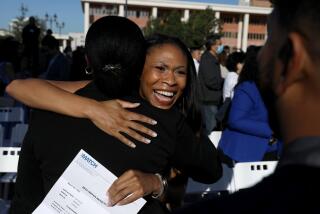Harbor-UCLA Medical Center cited for safety violations
- Share via
Harbor-UCLA Medical Center has failed to keep its operating rooms clean and safe and to protect its patients from possible infection, according to federal inspection reports recently released to The Times.
Inspectors found rooms that had holes in the ceilings or that were dusty and cluttered. Operating rooms were kept at the wrong humidity level, which can lead to the spread of germs, the reports said. Hospital staff members also weren’t washing their hands according to policy.
“The hospital failed to maintain a sanitary environment for the provision of surgical services,” the reports said. “This could lead to contaminated surfaces in the operating room and the spread of infection.”
The infection control problems found at the county-run hospital earlier this year were so serious that the federal government sent a letter this summer threatening to revoke Medicare funding, a move that could financially destroy the institution. The county submitted a plan of correction. The federal agency hasn’t issued its follow-up report.
“Thank God for the federal inspection,” said Los Angeles County Supervisor Mark Ridley-Thomas. “It is necessary for the purposes of accountability and quality of care.”
Rufus Arther, director of hospital operations for the California office of the Centers for Medicare & Medicaid Services, which oversees federal healthcare funding, said the agency never likes to arrive at a place where such a letter has to be sent. “We do not take these matters lightly at all,” he said.
Delvecchio Finley, who became the hospital’s chief executive earlier this month, said the Torrance-area hospital has addressed all the concerns raised by inspectors. The correction report noted several changes, including weekly audits of infection-control risks and more staff education on hand washing. Nevertheless, Finley said, issues continue to arise because of the age of the hospital, which was built in 1963.
“It’s an old building,” he said. “Because of that, there are certain challenges.”
Los Angeles County is spending nearly $323 million to construct a 190,000-square-foot building at the hospital that will replace both the surgical facilities and the emergency room. Completion is expected in 2013.
Ridley-Thomas said the new building is crucial because high-quality healthcare cannot happen in “decrepit” facilities. “It was known that the current conditions were simply unacceptable,” he said.
Miguel Ortiz-Marroquin, former chief executive, said Harbor-UCLA has constantly tried to stay ahead of inspectors and to correct problems as quickly as possible. But, he said, “until we have the new building open that will meet all the standards, we will be out of compliance.”
Harbor-UCLA, the only trauma center serving the South Bay, struggles to meet patient demand, especially in the emergency room. The hospital, which is affiliated with the UCLA Medical School, has 538 beds. In the last fiscal year, about 80,600 patients visited the emergency room and 23,000 patients were admitted to the hospital.
Since Martin Luther King Jr./Drew Medical Center closed in 2007, the hospital has seen an increase in patients, especially in the emergency room, administrators said.
Healthcare-associated infections are a serious issue nationwide, but there have been several successful efforts to reduce them, including programs to increase hand-washing at hospitals, according to Dr. James I. Cleeman, senior medical officer at the federal Agency for Healthcare Research and Quality.
“When a patient goes into a hospital, they are entitled to expect that they will not get sicker,” he said. “And the vast majority of healthcare-associated infections can be prevented.”
In addition to the federal reports, the California Department of Public Health also fined the hospital four times in 2008 and ’09 for medical errors that put patients at risk of serious injury or death. In one of those cases, a mix-up in labeling caused the wrong patient to have his prostate removed. In another, a sponge was inadvertently left in a patient’s abdomen during an operation.
The state also cited the hospital for not quickly screening and stabilizing two patients who went to the emergency room complaining of chest pain. Another patient who had been hit by a car died after nurses failed to closely monitor his condition, according to the state.
The hospital has remained accredited by the Joint Commission, though it had 21 complaints that met the criteria for review by the agency.
Health advocate Lark Galloway-Gilliam said the issues are alarming and the county must ensure that patients can receive safe, high-quality medical care at Harbor-UCLA and the county’s three other hospitals.
“You don’t want to be that family member of someone who comes down with an infection because someone didn’t follow protocol,” said Galloway-Gilliam, executive director of Community Health Councils in South Los Angeles.
Katarina del Valle Thompson, a union representative for the nurses at Harbor-UCLA, said she believes inadequate staffing has contributed to the problems. “The best thing we could do to minimize the chances of errors would be to staff adequately,” she said.
Several lawsuits also have been filed against the hospital in recent years, alleging medical malpractice and negligence. In January, the county settled a case for $1.175 million involving a woman whose blood vessel was injured during a procedure at the hospital. She had gone to Harbor-UCLA after being in a car accident.
All hospitals face some issues with patient safety and quality, but the problems at Harbor-UCLA should be taken very seriously, said James Lott, executive vice president of the Hospital Assn. of Southern California. The reports should put Harbor-UCLA on alert that it needs to improve — quickly.
“We only have to recall what happened with the former King/Drew Medical Center,” he said. “The downfall of that hospital started with these types of alerts.”
More to Read
Sign up for Essential California
The most important California stories and recommendations in your inbox every morning.
You may occasionally receive promotional content from the Los Angeles Times.













